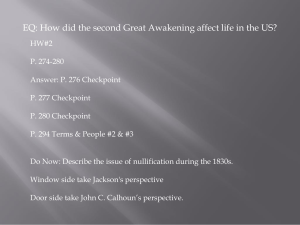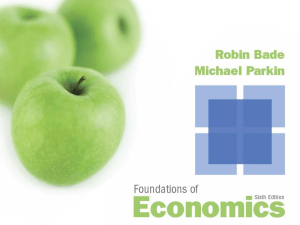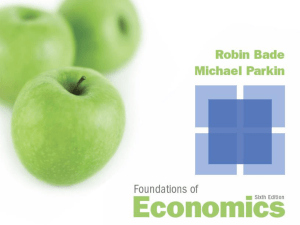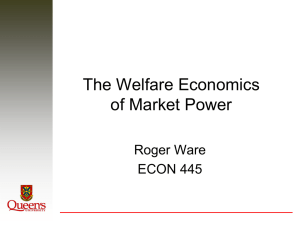Ch6
advertisement
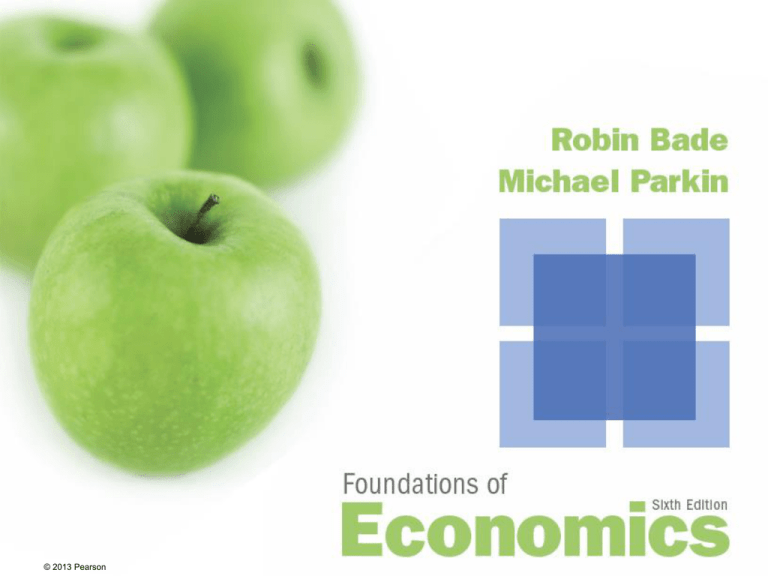
Click on the button to go to the problem © 2013 Pearson Efficiency and Fairness of Markets 6 CHECKPOINTS © 2013 Pearson Click on the button to go to the problem Checkpoint 6.1 Problem 1 Clicker version Checkpoint 6.2 Checkpoint 6.3 Problem 1 Problem 1 Problem 2 Problem 2 Problem 2 Problem 3 Problem 3 Problem 3 In the News In the News In the News © 2013 Pearson Click on the button to go to the problem Checkpoint 6.4 Checkpoint 6.5 Problem 1 Problem 1 Problem 2 Problem 2 Problem 3 In the news In the News © 2013 Pearson Clicker version Clicker version CHECKPOINT 6.1 Practice Problem 1 Which method is used to allocate the following scarce resources? • Campus parking space between student areas and faculty areas • A spot in a restricted student parking area • Textbooks • Host city for the Olympic Games © 2013 Pearson CHECKPOINT 6.1 Solution 1.Campus parking is allocated by command. 2.The spot in a restricted student parking area is allocated on a first-come, first-served basis. 3.Textbooks are allocated by market price (sharing). 4.The Olympic Games is allocated by contest. © 2013 Pearson CHECKPOINT 6.1 Study Plan Problem Which method is used to allocate campus parking space between student areas and faculty areas? A. B. C. D. E. Command First-come, first-served Contest Market price Majority rule © 2013 Pearson CHECKPOINT 6.1 Which method is used to allocate a spot in a restricted student parking area? A. B. C. D. E. Command Market price Contest First-come, first-served Majority rule © 2013 Pearson CHECKPOINT 6.1 Which method is used to allocate textbooks? A. B. C. D. E. Command Market price Contest First-come, first-served Majority rule © 2013 Pearson CHECKPOINT 6.1 Which method is used to allocate the host city for the Olympic Games? A. B. C. D. E. Command Market price Contest First-come, first-served Majority rule © 2013 Pearson CHECKPOINT 6.1 Practice Problem 2 The figure shows a nation’s PPF and Table 1 shows its marginal benefit and marginal cost schedules. What is the marginal benefit from bananas when 1 pound of bananas is grown? What is the marginal cost of growing 1 pound of bananas? © 2013 Pearson CHECKPOINT 6.1 Solution Marginal benefit is the amount of coffee that the nation is willing to give up to get one additional banana. The marginal benefit from bananas is 3 pounds of coffee. Marginal cost is the amount of coffee that the nation must give up to get one additional banana. The marginal cost of growing 1 pound of bananas is 1 pounds of coffee. © 2013 Pearson CHECKPOINT 6.1 Practice Problem 3 The figure shows a nation’s PPF and the table shows the marginal benefit and marginal cost schedules. On the figure, mark point A, at which production is efficient but with too much coffee produced to be a point of allocative efficiency. Also mark point B, the point of allocative efficiency. © 2013 Pearson CHECKPOINT 6.1 Solution Point A on the figure shows production efficiency (on PPF) but not allocative efficiency. Because with 1 banana, marginal benefit does not equal the marginal cost of a banana (from table). Because marginal benefit from a banana exceeds marginal cost of a banana, too few bananas are produced. © 2013 Pearson CHECKPOINT 6.1 Point B is the point of allocative efficiency because it is on the PPF and when the quantity of bananas is 2 pounds, marginal benefit from a banana equals the marginal cost of a banana (from the table). © 2013 Pearson CHECKPOINT 6.1 In the News AC/DC’s “Black Ice” tour breaks records down under The 40,000 tickets for the March 6 gig in Perth, Australia, sold out in seven minutes—a record. Many people who camped out overnight missed getting a ticket. Source: WAToday, May 25, 2009 What is the method used to allocate AC/DC concert tickets? Was the allocation of tickets efficient? © 2013 Pearson CHECKPOINT 6.1 Solution First-come, first-served is used to allocate AC/DC concert tickets. The allocation was efficient if the willingness to pay (the ticket price plus the opportunity cost of the buyer’s time), which is also the marginal benefit, equaled the marginal cost of providing one more seat. © 2013 Pearson CHECKPOINT 6.2 Practice Problem 1 The figure shows the demand curve for DVDs and the market price of a DVD. What is the willingness to pay for the 20th DVD? What is the value of the 10th DVD and the consumer surplus on the 10th DVD? © 2013 Pearson CHECKPOINT 6.2 Solution The willingness to pay for the 20th DVD is the price on the demand curve at 20 DVDs, which is $15. The value of the 10th DVD is its marginal benefit, which also is the maximum price that someone is willing to pay for it. The value of the 10th DVD is $20. © 2013 Pearson CHECKPOINT 6.2 The consumer surplus on the 10th DVD is its marginal benefit minus the price paid for the DVD. The length of the green arrow in the figure shows the consumer surplus on the 10th DVD. The consumer surplus on the 10th DVD is $20 $15, which equals $5. © 2013 Pearson CHECKPOINT 6.2 Practice Problem 2 The figure shows the demand curve for DVDs and the market price of a DVD. What is the quantity of DVDs bought and what is the consumer surplus on DVDs? What is the amount spent on DVDs and what is the total benefit from the DVDs bought? © 2013 Pearson CHECKPOINT 6.2 Solution The quantity of DVDs bought is 20 a day. The consumer surplus is the area of the green triangle, which equals ($25 - $15) x 20 ÷ 2. Consumer surplus is $100. © 2013 Pearson CHECKPOINT 6.2 The amount spent on DVDs is the price multiplied by the quantity bought, which is the area of the blue rectangle. The amount spent equals $15 x 20 = $300. The total benefit from DVDs is the amount spent on DVDs ($300) plus the consumer surplus from DVDs ($100), which is $400. © 2013 Pearson CHECKPOINT 6.2 Practice Problem 3 The figure shows the demand curve for DVDs and the market price of a DVD. If the price of a DVD rises from $15 to $20, what is the change in consumer surplus? © 2013 Pearson CHECKPOINT 6.2 Solution If the price of a DVD rises to $20, the quantity of DVDs bought decreases to 10 a day. The consumer surplus decreases to the area of the green triangle, which is ($25 $20) x 10 ÷ 2. The consumer surplus is $25. The consumer surplus decreases by $75 (from $100 to $25). © 2013 Pearson CHECKPOINT 6.2 In the News Airfares stacked against consumers Airlines change prices from day to day. For example, the fare on one Delta flight from New York to Los Angeles jumped from $755 to $1,143 from a Friday to Saturday in April, then fell to $718 on Sunday. Source: boston.com, June 22, 2011 Jodi planned a trip from New York to Los Angeles and was equally happy to travel on Friday, Saturday, or Sunday. The Saturday price was the most she was willing to pay. On which day do you think she traveled and how much consumer surplus did she receive? © 2013 Pearson CHECKPOINT 6.2 Solution Being equally happy to travel on any of these days means that Jodi’s marginal benefit from the trip was the same on each day. Because Saturday’s price of $1,143 was the most she was willing to pay, that is her marginal benefit. Being rational, Jodi would travel on the day with the lowest price, Sunday, and pay $718. Jodi’s consumer surplus equals her marginal benefit minus the price she paid, which equals $425. © 2013 Pearson CHECKPOINT 6.3 Practice Problem 1 The figure shows the supply curve for DVDs and the market price of a DVD. What is the minimum supply price of the 20th DVD? What is the marginal cost of the 10th DVD and the producer surplus on the 10th DVD? © 2013 Pearson CHECKPOINT 6.3 Solution The minimum supply price of the 20th DVD is the marginal cost of the 20th DVD which is $15. The marginal cost of the 10th DVD is equal to the minimum supply price for the 10th DVD which is $10. © 2013 Pearson CHECKPOINT 6.3 The producer surplus on the 10th DVD is the market price minus the marginal cost of producing the 10th DVD. The length of the blue arrow in the figure shows the producer surplus on the 10th DVD. The producer surplus on the 10th DVD is $15 $10, which equals $5. © 2013 Pearson CHECKPOINT 6.3 Practice Problem 2 The figure shows the supply curve of DVDs and the market price of a DVD. What is the quantity of DVDs sold and what is the producer surplus on DVDs? What is the total revenue from DVDs and what is the cost of producing the DVDs sold? © 2013 Pearson CHECKPOINT 6.3 Solution The quantity of DVDs sold is 20 a day. The producer surplus is the area of the blue triangle, which equals ($15 - $5) x 20 ÷ 2. Producer surplus is $100. © 2013 Pearson CHECKPOINT 6.3 The total revenue is the price multiplied by the quantity sold, which is the area of the blue triangle plus the red area. The total revenue equals $15 x 20 = $300. The total cost of producing DVDs is the red area, which equals the total revenue ($300) minus the producer surplus from DVDs ($100), which is $200. © 2013 Pearson CHECKPOINT 6.3 Practice Problem 3 The figure shows the supply curve of DVDs and the market price of a DVD. If the price of a DVD falls from $15 to $10, what is the change in producer surplus? © 2013 Pearson CHECKPOINT 6.3 Solution If the price of a DVD falls to $10, the quantity of DVDs produced decreases to 10 a day. The producer surplus, the area of the blue triangle, decreases to ($10 – $5) x 10 ÷ 2, which is $25. The change in producer surplus is a decrease of $75 (from $100 down to $25). © 2013 Pearson CHECKPOINT 6.3 In the News Is Australia’s ski season headed for a wipeout? The Australian dollar has soared 26% against the U.S. dollar since last June, making those foreign lift tickets cheaper than those in Australia, and travel agents report a jump in interest in travel to North American ski destinations like Vail and Aspen. Source: CNN.com, June 3, 2009 As Australians switch from skiing in Australia and flock to Vail and Aspen, how will the Australian ski operators’ producer surplus change? How will the Vail and Aspen ski operators’ producer surplus change . © 2013 Pearson CHECKPOINT 6.3 Solution Producer surplus is the excess of the price of a good over the marginal cost of producing it, summed over the quantity produced. In Australia, the demand for ski tickets decreases, the price and quantity of tickets sold decreases, and Australian ski operators’ producer surplus decreases. In Vail and Aspen, the demand for ski tickets increases, the price and quantity of tickets sold increases, and ski operators’ producer surplus increases © 2013 Pearson CHECKPOINT 6.4 Practice Problem 1 The figure shows the market for paper. At the market equilibrium, what are the consumer surplus, producer surplus, and total surplus? Is the market for paper efficient? Why or why not? © 2013 Pearson CHECKPOINT 6.4 Solution Market equilibrium is 40 tons a day at a price of $3 a ton. Consumer surplus equals the area of the green triangle, which is $(9 – 3) x 40 ÷ 2. Consumer surplus is $120. Producer surplus equals the area of the blue triangle, which is ($3 - $1) x 40 ÷ 2. Producer surplus is $40. © 2013 Pearson CHECKPOINT 6.4 Total surplus is the sum of consumer surplus ($120) and producer surplus ($40), which is $160. The market is efficient because marginal benefit (on the demand curve) equals marginal cost (on the supply curve) and total surplus is maximized. © 2013 Pearson CHECKPOINT 6.4 Practice Problem 2 The figure shows the market for paper. A news magazine lobbying group persuades the government to pass a law that requires producers to sell 50 tons of paper a day. Is the market for paper efficient? Why or why not? © 2013 Pearson CHECKPOINT 6.4 Solution The market is inefficient because at the quantity 50 tons a day, marginal cost exceeds marginal benefit. Deadweight loss equals the area of the gray triangle 1 in the figure. © 2013 Pearson CHECKPOINT 6.4 Practice Problem 3 The figure shows the market for paper. An environmental lobbying group persuades the government to pass a law that limits the quantity of paper that producers sell to 20 tons a day. Is the market efficient? Why or why not? What is the deadweight loss? © 2013 Pearson CHECKPOINT 6.4 Solution This market is now inefficient because at a quantity of 20 tons of paper a day, marginal benefit exceeds marginal cost. Deadweight loss equals the area of the gray triangle 2 in the figure. © 2013 Pearson CHECKPOINT 6.4 In the News Senate votes to end ethanol subsidies The Senate has voted to end the $6 billion a year in subsidies paid to the ethanol industry for the past three decades. Refiners would lose the 45-cent-a-gallon subsidy, and the tax on imported ethanol would be eliminated. Source: USA Today, June 3, 2009 Describe the efficiency of the market for ethanol with the $6 billion subsidies in place. If the subsidies and taxes are eliminated, explain how the efficiency of the market for ethanol would change. © 2013 Pearson CHECKPOINT 6.4 Solution Subsidies to producers increase the supply of the good, which decreases the market price. The price received by producers equals the market price plus the subsidy per gallon, which results in overproduction and inefficiency. A deadweight loss arises. By eliminating the subsidies and taxes, overproduction will decrease. The market for ethanol will be more efficient, and the deadweight loss will decrease. © 2013 Pearson CHECKPOINT 6.5 Practice Problem 1 A winter storm cuts the power supply and isolates a small town in the mountains. The people rush to buy candles from the town store, which is the only source of candles. The store owner decides to ration the candles to one per family, but to keep the price of a candle unchanged. Who gets to use the candles? Who receives the consumer benefit and who receives to producer benefit? © 2013 Pearson CHECKPOINT 6.5 Solution The people who buy candles from the town store are not necessarily the people who use the candles. A buyer from the town store can sell a candle and will do so if he or she can get a price that exceeds his or her marginal benefit. The people who value the candles most—who are willing to pay the most—will use the candles. © 2013 Pearson CHECKPOINT 6.5 Only the people who are willing to pay the most for candles receive the consumer surplus on candles. The store owner receives the same producer surplus as normal. People who sell the candles they buy from the store receive additional producer surplus. © 2013 Pearson CHECKPOINT 6.5 Study Plan Problem A winter storm cuts the power supply and isolates a small town. People rush to buy candles from the town store, the only source of candles. The store owner ration the candles to one per family, but to keep the price of a candle unchanged. Who receives the consumer surplus? Who receives the producer surplus? © 2013 Pearson CHECKPOINT 6.5 Who receives the consumer surplus? A. the store owner B. families that value the candle above the market price C. families that buy the candle from the store owner D. the store owner and the families that buy candles from the store owner © 2013 Pearson CHECKPOINT 6.5 Who receives the consumer surplus? A. The store owner and the families that resell their candles for more than the store’s market price B. The families that buy candles from the store owner C. The families that use the candles that they have bought from other families D. Only the store owner who sells the candles © 2013 Pearson CHECKPOINT 6.5 Practice Problem 2 A winter storm cuts the power supply and isolates a small town in the mountains. The people rush to buy candles from the town store, which is the only source of candles. The store owner decides to ration the candles to one per family, but to keep the price of a candle unchanged. Is the allocation efficient? Is the allocation fair? © 2013 Pearson CHECKPOINT 6.5 Solution The allocation is efficient because the people who value the candles most use them. Two views of fairness: The rules view is that if the rule of one candle per family is followed and exchange is voluntary, then the outcome is fair. But the results view is that if the candles are allocated unequally, then the allocation is unfair. © 2013 Pearson CHECKPOINT 6.5 Study Plan Problem A winter storm cuts the power supply and isolates a small town. People rush to buy candles from the town store, the only source of candles. The store owner ration the candles to one per family, but to keep the price of a candle unchanged. Is the allocation efficient? Is the allocation fair? © 2013 Pearson CHECKPOINT 6.5 The outcome is __________. A. inefficient because not everyone ends up with a candle B. efficient if the people who use the candles value the candles at more than the market price C. inefficient because both consumers and producers can receive a producer surplus D. inefficient if some consumers receive a smaller consumer surplus than others © 2013 Pearson CHECKPOINT 6.5 According to the fair _______ view, the outcome is considered ________. A. results; fair if the people who value a box of candles most end up with the candles B. rules; fair because the rule of one box of candles per family is unfair C. results; unfair if there are not enough boxes of candles D. rules; fair if exchange is voluntary © 2013 Pearson CHECKPOINT 6.5 In the News National parks to offer free-entry weekends Interior Secretary Ken Salazar said he hoped American families would take the opportunity during these hard times to enjoy an affordable weekend vacation in our national parks. Most Americans live within an hour’s drive of a national park. Source: Los Angeles Times, June 3, 2009 Which American families will most likely visit the national parks on the free weekends? Is the policy to waive the admission fair? © 2013 Pearson CHECKPOINT 6.5 Solution Most of the visitors will be those who own a car and don’t work on these weekends. The idea of waiving the admission is to allow families to enjoy an affordable vacation in these hard times. © 2013 Pearson CHECKPOINT 6.5 Solution If the families hit by the hard times are the ones that visit the parks, then, in the fair result view, the policy is fair. But if these families hit by the hard times are the ones who do not visit, then, in the fair result view, the policy is unfair. If the families visit the parks voluntarily, then, in the fair rules view, no matter which families visit, the policy is fair. © 2013 Pearson
